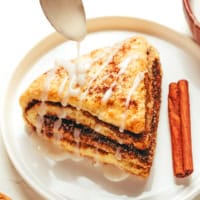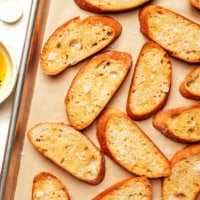How To Measure Flour Correctly
This post may contain affiliate links. Please read my disclosure policy.
Learn how to measure flour — both the right way, and the wrong way — with this quick 1-minute video. It can make a mega difference in the accuracy of your baking recipes!
Hey hey! Thought I’d pop in today with another How-To Tuesday video tutorial that may come in especially handy during holiday baking season this year. It may seem like the simplest thing in the world. But when done correctly, it can make a world of difference in ensuring the accuracy of your recipes, especially when baking.
We’re talking today about how to measure flour!
Chances are that if you taught yourself how to cook — oh hey, like me ? — you may have missed this learning this flour fundamental back in the day. Which wouldn’t be a prob if you lived in most other countries around the world, where flour is measured by weight. But in the States, where most people measure flour in measuring cups by volume, we have a tendency to accidentally scoop way too much flour in those cups, which can make a mega difference in your recipes. (For example, when measuring flour the wrong way, I’ve accidentally added 30% more flour to a measuring cup, even though it “looked” just right.) It’s an easy mistake to make. But thankfully, also a really easy one to fix.
So in hopes of rescuing all of our baked goods coming up this season, let’s all resolve to measure our flour the correct way, deal? Here’s how to do it.
How To Measure Flour Correctly | 1-Minute Video
Don’t…
- scoop straight from the flour container.
- tap the measuring cup on the side of the flour container to level it out.
- pack the flour down in the measuring cup.
All of these steps will more densely pack the flour into the measuring cup, resulting in too much flour.
Do…
- fluff the flour in the container before scooping it out. (Don’t skip this step!)
- spoon the flour gently into your measuring cup.
- level the flour out with a knife.
All of these steps will ensure that the flour nice and light and fluffy — both in the flour container, and once the flour has been portioned into the measuring cup — which will result in the proper amount of flour.
And just to double-check…
Weigh your flour:
- 1 cup all-purpose flour = 4.25 ounces
- 1 cup whole wheat flour = 4 ounces
- 1 cup white whole wheat flour = 4 ounces
- 1 cup bread flour = 4.25 ounces
- 1 cup self-rising flour = 4 ounces
Honestly, the best way to ensure that you have an accurate amount of flour is to weigh it. I’ve kept this handy little $20 kitchen scale (affiliate link) nearby in my pantry for years now, and always whip it out to measure flour, especially for baking recipes. It literally just takes 15 seconds to measure a cup of flour, and goes a long way in ensuring the accuracy of your recipes.
Alright, happy measuring everyone!












Good stuff! Now you should do one on why liquids should be measured with a liquid measuring cup and not the same cups used for dry items….. :) *some* people need convincing. ;)
This is a nice and simple explanation for everyone! Love it!
I have been guilty for most of my life of scooping flour into the measuring cup, but have recently changed my ways. I have always leveled it with a knife. I like being able to weigh the flour also (a bread recipe I recently made called specifically for weighing, which is not only easier, it makes for less dish washing. When I weight, I tend to use grams, because that is more accurate than ounces. Great tutorial!
Thank you ….I have always scooped the flour from the flour container…didn’t realize I should fluff it around first. I have had cookies not turn out right and may have had too much flour.
Amen to all that! Thanks for a great, simple tip that can make such a difference!
Yay, way to go. We Europeans have always struggled to understand why anyone would choose to measure dry goods by volume! Weighing is definitely more accurate – and you can now get those great scales that you just stand your mixing bowl on, then just keep pressing a button to take them back to zero every time you add something new – makes life so easy, and no extra washing up. Now then, while I am here… would someone be able to tell me the equivalent amount in weight (grams or ounces fine) for a tablespoon of butter. I keep coming across this in US recipes and I’m guessing our tablespoon measures might be different – a European tablespoon is 15ml. Thanks loads, Jayne
I love this chart: https://www.kingarthurflour.com/learn/ingredient-weight-chart.html
A stick of butter has 8 tablespoons so would be .5 oz or approximately 14 g.
What about cake flour? Is that 4.00 oz per cup as well? Thanks!
Pi
I’m wondering if this rule applies to scones. I’ve fluffed and spooned once when I made scones and they didn’t turn out right. Scones are supposed to be dense but they just fell apart. What is your advice about this? Thanks!
Wonder if this would be the same rule of thumb for a gluten free blend as well as almond flour?
I was also wondering what the weight for a cup of an all-purpose gluten free flour blend would be…?
I had no idea. Thank you!
Thank you Ali ,i have been measuring flour wrongly ,
thanks for the new methods.
I LOVE these super short videos. More please. So simple, clean, and minimal.